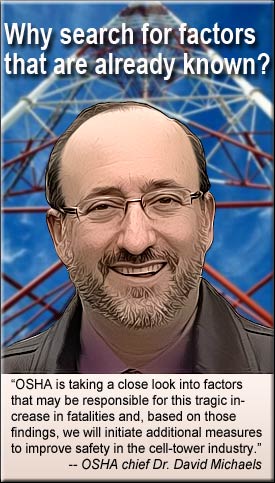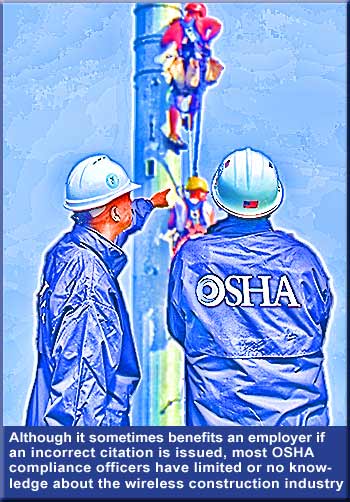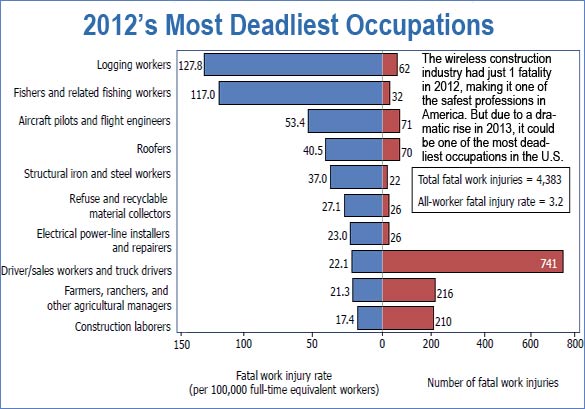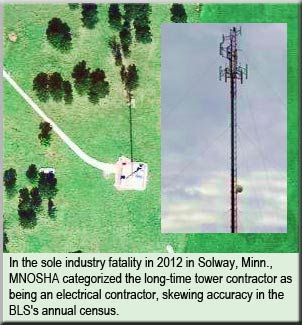OSHA doesn’t need to take a “close look” into climber fatality factors; they’re already known
Commentary
August 29, 2013 – The U.S. Bureau of Labor Statistics (BLS) released its annual Census of Fatal Occupational Injuries last week showing a preliminary total of 4,383 fatal work injuries in the U.S. in 2012, down from a revised count of 4,693 deaths in 2011.
 Steel and iron workers, who were sixth in 2011’s top ten deadly industries, were raised a notch by the BLS as the fifth highest in 2012 based upon their fatalities compared to their workforce size. Steel and iron workers, who were sixth in 2011’s top ten deadly industries, were raised a notch by the BLS as the fifth highest in 2012 based upon their fatalities compared to their workforce size.
The wireless construction industry, with seven fatalities in 2011, helped with the drop in deaths, recording only one in 2012.
However, this year’s 10 fatalities to date will add to the 2013 census, making the tower erection and maintenance industry one of the most deadly professions in America based upon its employee count.
And it’s captured the attention of Dr. David Michaels, Assistant Secretary of Labor for the Occupational Safety and Health Administration, who recently informed The Wall Street Journal that “OSHA is taking a close look into factors that may be responsible for this tragic increase in fatalities and, based on those findings, we will initiate additional measures to improve safety in the cell-tower industry."
One of those measures, according to the WSJ, would be to explore whether the industry’s deadline pressures are contributing to the increase in fatalities.
That appears to be something that OSHA shouldn’t single out the wireless industry for since it’s endemic in all industries, especially in the transportation-related profession where fatalities totaled 1,789 last year, 41% of the nation’s deaths, many of them from driver fatigue and having to live with razor thin margins if operators aren’t always on the road.
Climbers would be better served with other options
Here are some more focused suggestions for Secretary Michaels.
When there is a fatality or serious accident, don’t send out an investigator that doesn’t have an intimate knowledge of this industry.
OSHA officials and administrative law judges will readily admit that too often a well-meaning safety officer arrives on a site with limited or no knowledge about the exacting safety and installation disciplines required in the wireless construction industry.
An agreement would be helpful where an area director would allow an officer with industry expertise to be on call to assist whenever there is a need in another area or state, instead of relying upon the agency training tens of thousands of its compliance officers about tower construction – which will never happen.
Another avenue is to use outside tower industry safety consultants which has been done in the past by Indiana OSHA.
A third opportunity for Secretary Michaels would be to hire a tower expert that would be required to be used for investigations by state and federal offices and wasn’t just optional window dressing. The agency had one expert on staff until March of this year, but he resigned the position.
Although there is a hiring freeze, OSHA can reprogram funds to allow the agency to direct available funds toward high priority programs. That is, if Secretary Michaels truly believes that climber safety is a priority.
 All three opportunities would provide for a more constructive dialog with worksite employees and employers following a serious accident or fatality, and might even facilitate less citations being contested if the employer realizes they were at fault, based upon the accuracy of the facts presented by the inspecting officer. All three opportunities would provide for a more constructive dialog with worksite employees and employers following a serious accident or fatality, and might even facilitate less citations being contested if the employer realizes they were at fault, based upon the accuracy of the facts presented by the inspecting officer.
Of the 4,383 fatalities last year, only one OSHA official was required to have the expertise to investigate a death in the wireless construction industry which reportedly was caused, in part, by a tower technician not being tied off 100%.
Midwest Steeplejacks Inc. was cited for two serious violations totaling $25,500 in fines which Midwest contested on December 6, 2012. The case has not been closed by Minnesota’s state OSHA, according to federal OSHA reports.
In 2012, MNOSHA had 41 safety inspectors available to investigate 17 fatalities.
Citation 1 for Midwest Steeplejacks of $25,000 was under Personal Climbing Equipment -- 1910.268(g)(1).
Citation 2 for $500 was for not complying with a training requirement -- 19100268 (c).
Seven out of 10 fatalities were fall protection issues
If Secretary Michael’s were to perform a cursory review of the nation’s 10 industry-related fatalities in 2013 he would find that:
One fatality was through the unacceptable disregard for all safety practices by a sole proprietor of a company which OSHA believed there was no need to investigate since the company went out of business when the owner died.
Two fatalities on the same work site reportedly occurred after a gin pole’s rigging failed.
Seven fatalities were directly related, according to initial reports, to workers not tying off 100%.
If 70% of all of the industry’s fatalities were a direct result of not tying off at all times, or from the proper usage of, but malfunctioning safety equipment, there’s no need for OSHA to investigate the wireless construction industry and provide additional measures to improve safety.
Those methods, procedures and regulations are already in place. They’re just not being observed or enforced by supervisors and/or the climber who must be challenged to take personal responsibility for his or her safety.
Equally as important, they’re not being enforced by OSHA. And as much as the industry is terrified that OSHA might show up unannounced at a job site, they’re simply not investigating company compliance issues until there is a fatality or multiple injuries.
OSHA needs to review each fatality with a qualified inspector to identify, in the cases involving fall protection, whether the tower technician was at fault, if the employer was negligent in its obligations or if there was an equipment failure, as well as assess whether citations should be issued under the multi-employer worksite liability doctrine.
Seventy percent of the 10 fatalities occurred on cell carrier network installations. One non-cell-tower project death was a two-way radio tower removal and two deaths occurred on a microwave project for a utility company.
If Secretary Michaels would direct a member of his staff to provide a consensus report regarding the 10 fatalities, once they are closed or the facts are known, as to what happened and provide constructive feedback and guidance, it could easily result in preventing additional fatalities.
It’s a wonderful tradeoff for the 75 hours or so that it might take to provide the information versus the hundreds of hours it would take an OSHA inspector, their area director and other staffers to investigate and/or mitigate citations following another unnecessary fatality.
Or the agency can go on one of their signature public relations offensives in reaction to the WSJ article to show that they are concerned about the high death count and move forward with a pablum plan of asking all shareholders, from carriers to climbers, to take safety more seriously.
Let’s hope Secretary Michaels banks those hours more effectively.
Some BLS statistics use misidentified NAICS codes
The BLS provides a full listing of fatalities from which they generated their top ten most deadly professions for 2012.

Loggers were clearly identified as having 62 fatalities last year, but iron and steel workers are not classified separately and are captured from numerous North American Industry Classification System codes (NAICS) as identified by company and OSHA officials in the fatality investigation.
However, it is not uncommon for a company’s NAICS to be incorrectly applied, either on purpose to obtain a lower workers compensation insurance premium, or due to a lack of industry conformity when there is no specific NAICS such as telecommunications tower installation and maintenance, and an incorrect OSHA-36 form ends up providing a skewed BLS count.
 Although Midwest Steeplejacks has been primarily erecting and servicing communications towers since its founding in 1973, the MNOSHA investigation identifies that the company’s primary NAICS is 238210 – electrical contractors. Although Midwest Steeplejacks has been primarily erecting and servicing communications towers since its founding in 1973, the MNOSHA investigation identifies that the company’s primary NAICS is 238210 – electrical contractors.
In previous research by Wireless Estimator, with the assistance of OSHA officers, it was identified that numerous tower-industry-deaths were miscategorized to professions far removed from wireless construction and maintenance.
In 2008, then Assistant Secretary of Labor, Edwin G. Foulke, Jr., said in a speech that, according to OSHA’s and Wireless Estimator’s research, coupled with BLS data, tower technicians had the most dangerous job in America.
Employee misconduct is a frequent defense
Since then, Foulke, a partner at law firm Fisher & Phillips LLP, has carved out an industry niche representing tower companies that have had a serious injury or fatality.
If applicable, one of the first defenses a company will use if there is a citation relative to not being 100% tied off is the “employee misconduct defense.”
The basic premise of this defense is that it would be unfair and would not promote employee safety and health to penalize an employer for conditions caused by an employee that were unpreventable and not likely to recur.
In order to establish this defense, an employer must be able to demonstrate that (1) the violation charged resulted exclusively from the employee’s conduct; (2) the violation was not participated in, observed by, or performed with the knowledge and/or consent of any supervisory personnel; and (3) that the employee’s conduct contravened a well-established company policy or work rule which was in effect at the time, well-publicized to the employees, and actively enforced through disciplinary action or other appropriate procedures.
Incorrect citations, lack of prosecution let some companies walk
In all cases, whether it’s state or federal OSHA, the agency has the burden of proving that the alleged violation occurred and that the agency correctly determined the level of negligence, gravity and aggravating factors.
Unless an alternative standard is properly filed, oftentimes the applicability of the cited standard is incorrect and will require an administrative law judge to vacate the citation or force the area director to mediate it before it is contested, even if it is apparent that the employer was at fault.
Statistically, most employers will fold at OSHA’s informal hearing.
According to former OSHA officials, there have been multiple instances in the wireless construction industry where compliance officers correctly cited an employer for serious and willful violations, but the Office of the Solicitor, the legal arm of the federal agency, wouldn’t go after the company in court, requiring the area director to negotiate a settlement.
Solicitors want cases that are slam dunks, a former OSHA investigator told Wireless Estimator. “If they think that they could lose it, they’re going to recommend that it does not go before a judge,” he said.
Although solicitors will state that they have resource issues and are unable to try every case, an OSHA consultant said that is oftentimes not the reason.
“Some of them just take the easy way out because they’re scared to go up against a competent attorney that understands labor law. They almost become paralyzed at the thought,” he said.
|